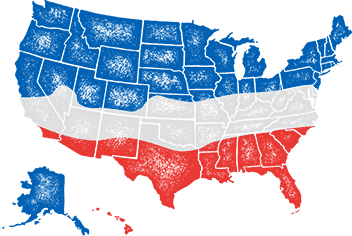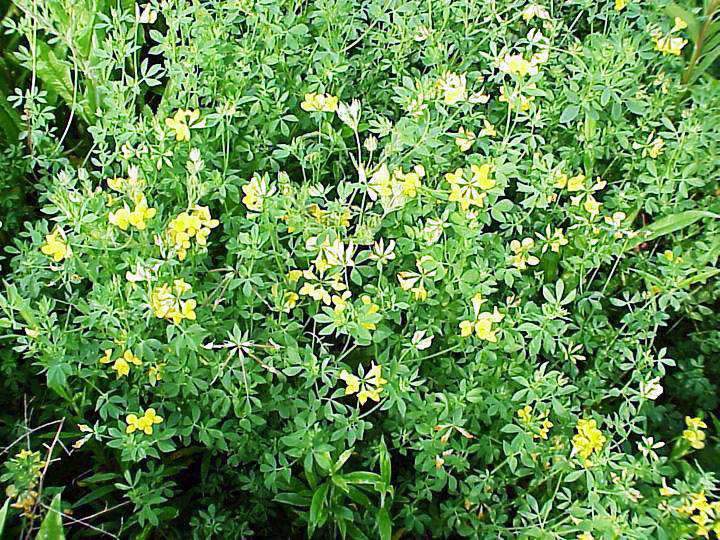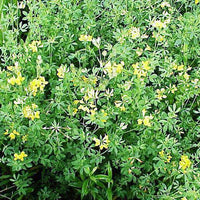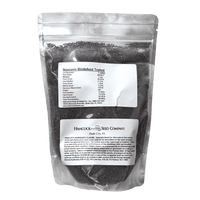
- When to plant:
- Spring
- Fertilizer:
- Varies
- Seeding rate:
- 5 - 10 lbs. per acre
- Overseeding rate:
- 5 lbs. per acre
- Seeding depth:
- 1/4 inch
- Ideal ph:
- 5.5 - 7.5
- Gmo:
- No
- Inoculant needed:
- EL Type Inoculant - Garden Combo
- Coated or raw:
- Raw
- Lifecycle:
- Perennial
- Climate zones:
- Cool Season, Transition Zone, Warm Season
Birdsfoot Trefoil is a long-lived perennial legume, ideally suited for many pastures in the central northeast. Birdsfoot Trefoil grows and produces forage during July and August, when most cool-season grasses are semi-dormant. Trefoil does not cause bloat, as do many other commonly used legumes.
Product Information
- Application or Use: Cover Crop, Livestock Forage, Hay Production, Cattle Grazing
- Germination Time: 21 - 28 days, under optimal conditions
- Growing Locations: Warm Season, Transition Zone, Cool Season
- Height: 12 - 24 inches
- Sunlight Requirements: 4 - 8 hours, full sun for best results
- Advantages: Persistent to variety of soil types, produces uniform forage production, tolerant to maritime exposure.
- When to Plant: Recommended planting time is springtime when night time temperatures are consistently below 65 degrees.
Product Description
- Perennial legume
- Produces forage during July and August
- 30% higher daily gains in grass pastures for grazing animals
- More uniform distribution of forage production
- Insensitive to acidic soils
Birdsfoot trefoil should be used primarily as a pasture legume. It should not be expected to replace alfalfa or other forages as a hay crop, due to it not having the yielding ability of most legumes when managed as a hay crop. During the seedling period (first 60 to 90 days of life), it is less aggressive than most plants, so competition from other plants must be controlled.
Birdsfoot trefoil is more persistent in the northern and central regions. It produces exceptionally well on Shelby-Grundy and similar soil types. A combination of Trefoil and Bluegrass or other cool-season grasses will produce three-times as much feed as unimproved grass. Even heavily-fertilized grass will produce one-third less beef per acre than a Trefoil-Bluegrass combination.
Exceed Peat Trefoil Inoculant is recommended for Birdsfoot Trefoil Seed.
*Product packaging may appear different than what is pictured.
Plant in the springtime at a rate of 5 - 10 lbs per acre and at a depth of 1/4 inch. This seed prefers a pH of 5.5 to 7.5.
When choosing to start a new lawn, remove old vegetation by using a de-thatcher, power rake or tiller to kill the existing vegetation. Rake or drag the area to remove debris and dead grass for a clean area. Ensure the soil is leveled and loosened to allow the seed to have good soil contact once spread on a clean seed bed.
If you have an area with heavy weed coverage, we recommend starting fresh by killing and removing the existing vegetation. If you choose to use chemicals, herbicides or fertilizers, you must check with the product's manufacturer prior to planting new seed to ensure the proper waiting period.
When overseeding an existing area, mow your lawn at the lowest setting and bag the clippingsx. Rake or drag any areas that have dead thatch or debris.

Seed Quality
Hancock Seed is dedicated to delivering the best seeds possible to our customers. Hancock Seed grows and harvests many of our products, and we acquire the majority of the rest from other family farmers.
All these seeds are processed, packaged and shipped from Hancock Farm. This helps us ensure that our high standards are met. Unlike much of the competition, we refuse to sell you a seed that was not gathered during the last harvest. You will always receive fresh product from Hancock.
Every seed we grow comes with 40 years of experience behind it...you can rest assured that all of our products are cultivated in a method that assures its potential for growth.

Your cart ( 0 )

Birdsfoot Trefoil is a long-lived perennial legume, ideally suited for many pastures in the central northeast. Birdsfoot Trefoil grows and produces forage during July and August, when most cool-season grasses are semi-dormant. Trefoil does not cause bloat, as do many other commonly used legumes.
Product Information
- Application or Use: Cover Crop, Livestock Forage, Hay Production, Cattle Grazing
- Germination Time: 21 - 28 days, under optimal conditions
- Growing Locations: Warm Season, Transition Zone, Cool Season
- Height: 12 - 24 inches
- Sunlight Requirements: 4 - 8 hours, full sun for best results
- Advantages: Persistent to variety of soil types, produces uniform forage production, tolerant to maritime exposure.
- When to Plant: Recommended planting time is springtime when night time temperatures are consistently below 65 degrees.
Product Description
- Perennial legume
- Produces forage during July and August
- 30% higher daily gains in grass pastures for grazing animals
- More uniform distribution of forage production
- Insensitive to acidic soils
Birdsfoot trefoil should be used primarily as a pasture legume. It should not be expected to replace alfalfa or other forages as a hay crop, due to it not having the yielding ability of most legumes when managed as a hay crop. During the seedling period (first 60 to 90 days of life), it is less aggressive than most plants, so competition from other plants must be controlled.
Birdsfoot trefoil is more persistent in the northern and central regions. It produces exceptionally well on Shelby-Grundy and similar soil types. A combination of Trefoil and Bluegrass or other cool-season grasses will produce three-times as much feed as unimproved grass. Even heavily-fertilized grass will produce one-third less beef per acre than a Trefoil-Bluegrass combination.
Exceed Peat Trefoil Inoculant is recommended for Birdsfoot Trefoil Seed.
*Product packaging may appear different than what is pictured.
Plant in the springtime at a rate of 5 - 10 lbs per acre and at a depth of 1/4 inch. This seed prefers a pH of 5.5 to 7.5.
Instructions
When choosing to start a new lawn, remove old vegetation by using a de-thatcher, power rake or tiller to kill the existing vegetation. Rake or drag the area to remove debris and dead grass for a clean area. Ensure the soil is leveled and loosened to allow the seed to have good soil contact once spread on a clean seed bed.
If you have an area with heavy weed coverage, we recommend starting fresh by killing and removing the existing vegetation. If you choose to use chemicals, herbicides or fertilizers, you must check with the product's manufacturer prior to planting new seed to ensure the proper waiting period.
When overseeding an existing area, mow your lawn at the lowest setting and bag the clippingsx. Rake or drag any areas that have dead thatch or debris.


















